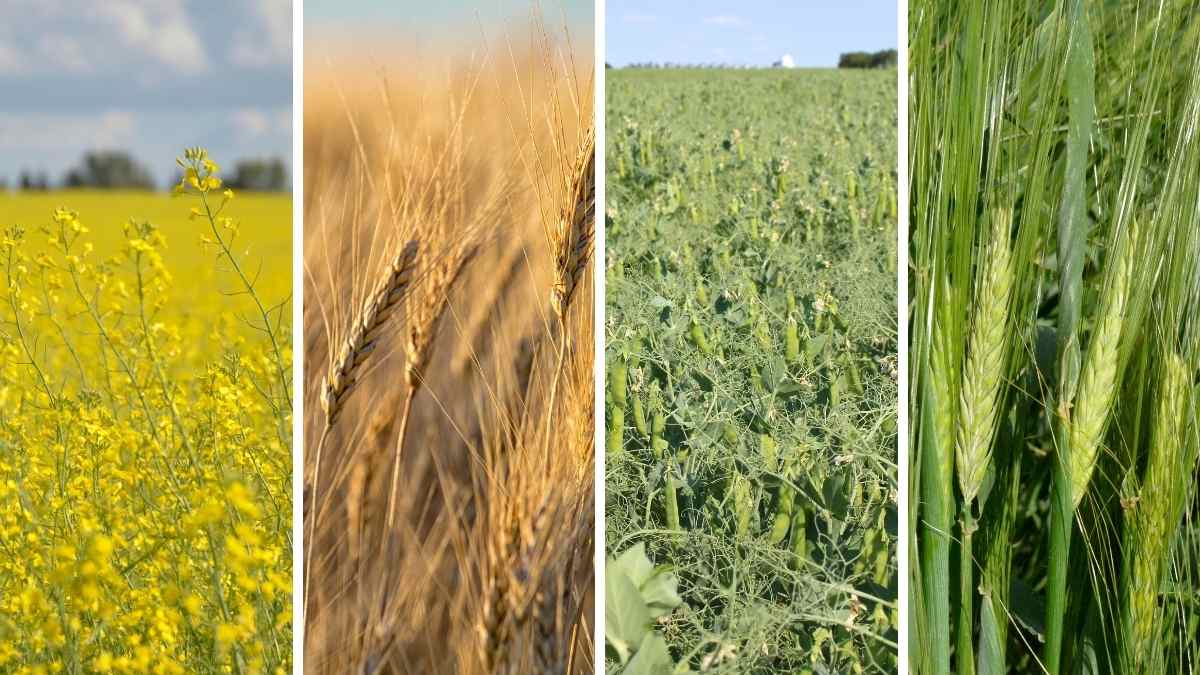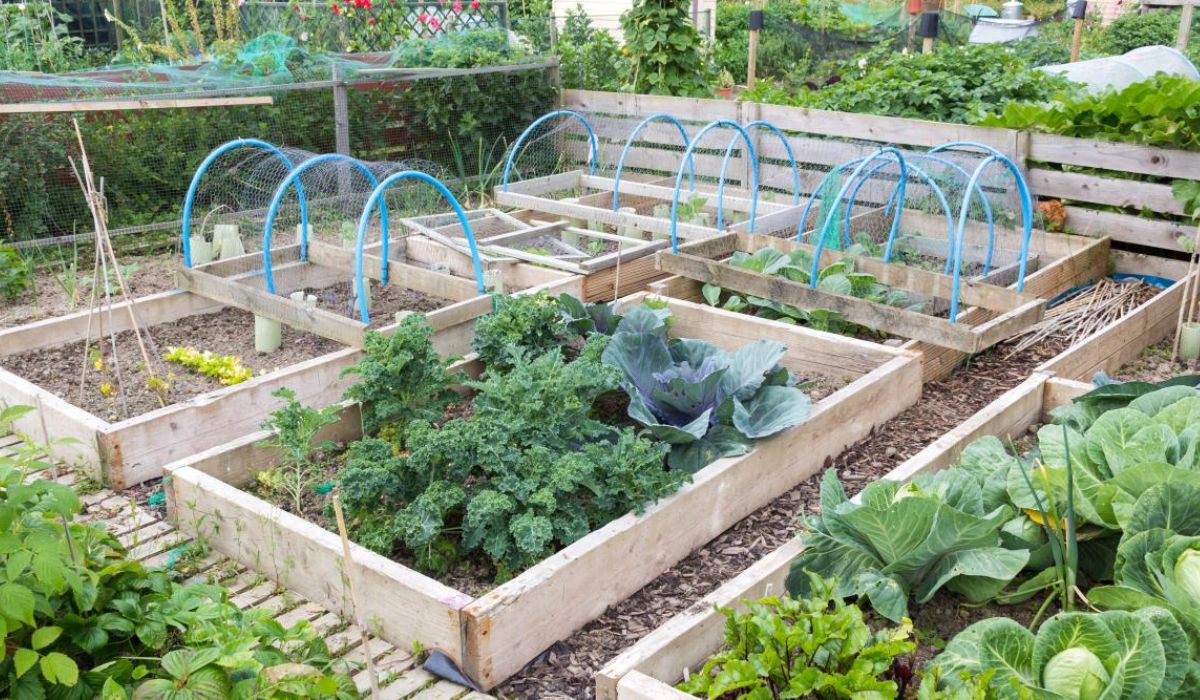Home>Garden Essentials>How Do Rest Crops Relate To Crop Rotation?


Garden Essentials
How Do Rest Crops Relate To Crop Rotation?
Modified: March 16, 2024
Discover the importance of rest crops in garden crop rotation. Improve your garden's soil health and increase crop yields with this essential gardening practice.
(Many of the links in this article redirect to a specific reviewed product. Your purchase of these products through affiliate links helps to generate commission for Storables.com, at no extra cost. Learn more)
Introduction
When it comes to successful gardening and sustainable agricultural practices, crop rotation plays a crucial role. One vital aspect of crop rotation is the incorporation of rest crops. But what exactly are rest crops, and how do they relate to crop rotation? In this article, we will explore the definition of rest crops, their benefits, and their role in improving soil health, controlling weeds, and managing pests and diseases.
Rest crops, also known as fallow crops or green manure crops, are specific plant species that are deliberately grown in rotation with traditional cash crops. Unlike cash crops, the primary purpose of rest crops is not for harvest or sale but rather to provide various benefits to the overall farming system. These benefits include improving soil structure, replenishing nutrients, reducing weed pressure, managing pests and diseases, and promoting overall soil health and fertility.
The use of rest crops in crop rotation systems dates back centuries and is based on the understanding that different plant species have diverse effects on the soil ecosystem. By strategically integrating rest crops into the rotation sequence, farmers can optimize soil health and minimize the reliance on synthetic inputs such as fertilizers and pesticides.
Next, let’s explore the specific advantages that rest crops bring to crop rotation systems.
Key Takeaways:
- Rest crops, like legumes and grasses, are not harvested but improve soil, control weeds, and manage pests. They help farmers grow healthier crops and reduce the need for chemicals.
- Farmers should carefully choose and manage rest crops to ensure they benefit the soil and prevent issues like weed growth and disease. Proper planning and care lead to successful and sustainable farming.
Definition of Rest Crops
Rest crops, also referred to as cover crops or green manure crops, are plant species that are intentionally grown as part of a crop rotation system. Unlike cash crops, rest crops are not cultivated for their fruits, vegetables, or other products but rather for the benefits they provide to the soil and the overall farming system.
Rest crops are typically sown during specific periods of the year when the land would otherwise be left fallow or empty. They are chosen for their ability to improve soil health, nutrient cycling, weed control, pest and disease management, and overall sustainability of the agricultural system.
The selection of rest crops depends on various factors, including climate, soil type, crop rotation schedule, and specific objectives. Some common types of rest crops include legumes, grasses, and brassicas. Legume rest crops, such as clover or vetch, have the added benefit of fixing atmospheric nitrogen through a process called nitrogen fixation, which enriches the soil with this essential nutrient.
Rest crops can be either winter or summer cover crops, depending on the growing season and weather conditions. Winter cover crops are typically planted in late summer or early fall and provide soil protection and ground cover during the winter months. They help prevent erosion, improve water infiltration, and reduce nutrient leaching. Summer cover crops are planted after the cash crop is harvested, often during the warmer months. They assist in maintaining soil moisture, suppressing weeds, and adding organic matter to the soil.
It is important to note that the term “rest crop” can also be used in a broader context to describe crops that are not part of the traditional cash crop rotation system but are grown to allow a period of rest or recovery for the land. This practice is particularly relevant in areas where intensive farming has depleted the soil’s fertility and requires a period of rejuvenation.
In the next sections, we will explore the benefits and role of rest crops in more detail, highlighting their significance in soil improvement, weed control, nutrient cycling, and pest and disease management within crop rotation systems.
Benefits of Rest Crops in Crop Rotation
Rest crops offer a multitude of benefits when incorporated into crop rotation systems. These benefits range from enhancing soil health to improving weed control, nutrient cycling, and pest and disease management. Let’s take a closer look at the advantages that rest crops bring to agricultural practices:
- Soil Improvement: One of the primary benefits of rest crops is their ability to improve soil health. Rest crops help prevent soil erosion by providing ground cover and protecting the soil from wind and water erosion. Their extensive root systems penetrate deep into the soil, improving soil structure, aeration, and water retention capacity. As rest crops decompose, they add organic matter to the soil, increasing its microbial activity and nutrient-holding capacity.
- Weed Control: Rest crops can play a crucial role in weed management within crop rotation systems. They act as living mulches, suppressing weed growth by competing for space, light, and nutrients. Additionally, some rest crops release allelopathic substances that inhibit the growth of certain weed species. By reducing weed pressure, rest crops minimize competition for resources and create a more favorable environment for cash crops.
- Nutrient Cycling: Rest crops help in nutrient cycling and conservation within the farming system. Through their extensive root systems, they extract nutrients from deeper soil layers, making them available for the succeeding cash crops. Rest crops, particularly legumes, have the unique ability to fix atmospheric nitrogen through a symbiotic relationship with nitrogen-fixing bacteria present in their root nodules. This nitrogen fixation process enriches the soil with a vital nutrient, reducing the need for synthetic nitrogen fertilizers and promoting more sustainable farming practices.
- Pest and Disease Management: Rest crops can contribute to effective pest and disease management in crop rotation systems. Some rest crops, such as marigolds or mustard greens, have natural properties that repel or suppress certain pests and pathogens. This phenomenon, known as allelopathy, can help reduce pest infestations and disease outbreaks in subsequent cash crops. Rest crops also enhance beneficial insect populations, such as pollinators and predators, which contribute to natural pest control.
- Water Management: Rest crops serve as excellent tools for water management in agricultural systems. Their deep root systems help improve soil infiltration and reduce surface runoff, minimizing soil erosion and nutrient runoff. Rest crops also contribute to water conservation by reducing evaporation and maintaining soil moisture levels, particularly during dry spells or in regions with limited water resources.
The benefits of rest crops in crop rotation systems are numerous and have a positive impact on soil health, weed control, nutrient cycling, pest and disease management, and water conservation. Incorporating rest crops into farming practices promotes sustainable agriculture, reduces reliance on synthetic inputs, and supports the long-term productivity and resilience of the farming system.
Role of Rest Crops in Soil Improvement
Rest crops play a vital role in improving soil health and fertility within crop rotation systems. Through their various mechanisms, rest crops contribute to soil improvement in several ways:
- Organic Matter Addition: One of the key contributions of rest crops is the addition of organic matter to the soil. As rest crops decompose, they release nutrients, carbon, and other organic compounds into the soil. This organic matter acts as a food source for soil organisms, stimulating microbial activity and promoting nutrient cycling. It also improves soil structure, aggregate stability, and water-holding capacity, enhancing overall soil health.
- Enhanced Soil Structure: Rest crops, with their extensive root systems, help improve soil structure by increasing aggregation and porosity. Their roots create channels and pores in the soil, allowing for better water infiltration and root penetration of subsequent cash crops. Improved soil structure enhances nutrient availability, root development, and water retention capacity, leading to healthier and more productive plant growth.
- Soil Erosion Prevention: The root systems of rest crops help hold the soil together, reducing the risk of erosion by wind and water. The aboveground biomass of rest crops acts as a protective cover, shielding the soil surface from the impact of raindrops and wind forces. This protection is especially valuable during periods when cash crops are not actively growing, such as winter months or offseasons. By preventing soil erosion, rest crops help maintain the integrity of the topsoil, which is essential for nutrient retention and plant productivity.
- Nutrient Accumulation: Rest crops, particularly legumes, have the ability to accumulate nutrients from deeper soil layers. Their extensive root systems reach deeper into the soil profile, accessing nutrients that may not be readily available to other crops. As the rest crops decompose, the accumulated nutrients are released back into the soil, replenishing the nutrient pool and making them available for subsequent cash crops. This nutrient accumulation and release process contributes to improved soil fertility and reduces the need for synthetic fertilizers.
- Microbial Activity Enhancement: Rest crops support a diverse and active soil microbial community. The presence of living roots and the decomposition of rest crop residues provide a favorable environment for soil microorganisms, such as bacteria, fungi, and earthworms. These microorganisms play a crucial role in nutrient cycling, organic matter decomposition, and disease suppression. By promoting microbial activity, rest crops contribute to improved nutrient availability, soil structure, and overall soil health.
The role of rest crops in soil improvement cannot be overstated. Their contributions to organic matter addition, enhanced soil structure, erosion prevention, nutrient accumulation, and microbial activity enhancement all work together to create fertile, resilient, and productive soils. By incorporating rest crops in crop rotation systems, farmers can nurture the health and productivity of their land, leading to sustainable and long-term agricultural success.
How Rest Crops Help in Weed Control
Rest crops play a crucial role in weed control within crop rotation systems. By integrating rest crops into the rotation cycle, farmers can effectively suppress weed growth and reduce the reliance on herbicides. Here are several ways in which rest crops contribute to weed control:
- Competition for Resources: Rest crops compete with weeds for essential resources such as sunlight, water, and nutrients. Their vigorous growth and dense canopy shade out weed seedlings, limiting their access to light and inhibiting their growth. By occupying space and utilizing resources, rest crops reduce the available resources for weeds, effectively suppressing their growth and minimizing weed infestations.
- Allelopathy: Some rest crops have allelopathic properties, meaning they release natural chemicals or compounds that inhibit the growth of certain weed species. These allelopathic substances can be present in the root exudates, leaf litter, or decomposing residues of the rest crops. The allelopathic effect can deter weed germination, root growth, and seedling vigor, giving the rest crops an additional advantage in weed control.
- Ground Cover and Smothering Effect: Rest crops, with their dense aboveground biomass, provide effective ground cover, effectively smothering weeds and preventing their establishment. The shade and physical barrier created by the rest crop canopy inhibit weed seed germination and prevent weed seedling emergence. This smothering effect reduces weed pressure, creating a more favorable environment for subsequent cash crops.
- Root Exudates and Weed Suppression: The root exudates of some rest crops contain compounds that suppress weed growth. These compounds can inhibit weed seed germination, root elongation, or nutrient uptake by competing weed species. Rest crops with allelopathic properties can release these weed-suppressive chemicals into the soil, effectively inhibiting the growth and development of weeds within the crop rotation system.
- Preventing Soil Disturbance: Rest crops help in reducing soil disturbance, which can promote weed growth. By keeping the soil covered and protected, rest crops prevent weed seeds from being exposed to favorable germination conditions, such as light and air. This prevents weed seed dormancy from breaking and reduces the overall weed seedbank in the soil, making it harder for weeds to establish and thrive.
Rest crops, with their competitive advantage, allelopathic properties, ground cover, and smothering effect, significantly contribute to weed control within crop rotation systems. By integrating rest crops into the farming system, farmers can reduce reliance on herbicides, mitigate weed competition, and decrease weed seedbank accumulation. This approach not only helps in weed control but also promotes more sustainable and environmentally friendly farming practices.
Rest crops, also known as fallow or cover crops, are an important part of crop rotation. They help improve soil health by adding nutrients and preventing erosion. When planning crop rotation, consider including rest crops to maintain soil fertility and reduce pest and disease pressure.
Nutrient Cycling and Rest Crops
Rest crops play a vital role in nutrient cycling within crop rotation systems. They contribute to the efficient use and recycling of nutrients, reducing the reliance on synthetic fertilizers and promoting sustainable agricultural practices. Here are several ways in which rest crops facilitate nutrient cycling:
- Accumulation and Redistribution: Rest crops, particularly legumes, have the ability to accumulate nutrients, especially nitrogen, from deeper soil layers. Their extensive root systems access nutrients that may not be readily available to other crops. As the rest crops decompose, they release these accumulated nutrients back into the soil, making them available for subsequent cash crops. This accumulation and redistribution process helps in maintaining nutrient balance and fertility within the farming system.
- Nitrogen Fixation: Legume rest crops have a unique ability to engage in a symbiotic relationship with nitrogen-fixing bacteria present in their root nodules. This process, known as nitrogen fixation, allows legumes to convert atmospheric nitrogen into a form that plants can utilize. As rest crops, legumes enrich the soil with nitrogen, an essential nutrient for plant growth. This reduces the reliance on synthetic nitrogen fertilizers, which can have negative environmental impacts, and promotes more sustainable nutrient management practices.
- Root and Organic Matter Decomposition: The root systems and organic matter residues of rest crops contribute to the overall organic matter content of the soil. As these plant materials decompose, they release nutrients, carbon, and other organic compounds into the soil. This decomposition process is facilitated by soil microorganisms, such as bacteria and fungi, which break down the organic matter and release nutrients for plant uptake. The organic matter decomposition and nutrient release from rest crops contribute to nutrient cycling, making nutrients available for subsequent crops.
- Reduced Nutrient Losses: Rest crops help reduce nutrient losses through leaching and runoff. When implemented as winter cover crops, they capture and hold nutrients that would otherwise be lost during the dormant season. The deep root systems of rest crops access nutrients in lower soil layers, preventing them from leaching beyond the root zone. Additionally, the aboveground biomass of the rest crops acts as a physical barrier, reducing nutrient runoff and soil erosion by disrupting the flow of water over the soil surface.
- Improved Soil Fertility: By promoting nutrient cycling, rest crops contribute to improved soil fertility. The release of organic matter and nutrients from decomposing rest crops enhances soil nutrient levels and availability. This, in turn, provides a fertile environment for subsequent cash crops, supporting their growth and productivity. Rest crops also help in maintaining a balanced nutrient profile in the soil, ensuring that all essential nutrients are available in adequate amounts for optimal plant nutrition.
Through nutrient accumulation and redistribution, nitrogen fixation, organic matter decomposition, reduced nutrient losses, and improved soil fertility, rest crops contribute significantly to nutrient cycling within crop rotation systems. By incorporating rest crops into agricultural practices, farmers can optimize nutrient utilization, reduce the dependency on synthetic fertilizers, and promote more sustainable and environmentally friendly farming methods.
Disease and Pest Management through Rest Crops
Rest crops play an important role in disease and pest management within crop rotation systems. By strategically integrating rest crops into the rotation cycle, farmers can reduce the incidence of diseases and pests, minimizing the need for synthetic pesticides and fostering a more sustainable farming environment. Here are several ways in which rest crops contribute to disease and pest management:
- Interrupting Disease and Pest Life Cycles: Rest crops can disrupt the life cycles of diseases and pests by providing a break in the favorable conditions they need to survive. By interrupting the continuous growth of susceptible crops, rest crops reduce the build-up of specific diseases and pests. This break helps to minimize the carryover of pathogens and pests from one crop cycle to the next, reducing the risk of disease outbreaks and pest infestations.
- Host Plant Resistance: Some rest crops possess natural resistance to certain diseases and pests. By including these resistant plants in the rotation, farmers can effectively manage specific pathogens or pests without relying on chemical interventions. Rest crops with natural resistance can act as a barrier or trap crop, attracting pests away from cash crops or providing a less favorable environment for disease development.
- Allelopathic Effects: Some rest crops release allelopathic chemicals that have inhibitory effects on specific pests or diseases. These compounds can repel or suppress the growth and development of pests and pathogens. For example, marigolds are known for their allelopathic properties, which can deter certain nematodes and soil-borne pathogens. Incorporating these allelopathic rest crops in rotation systems can help in naturally managing pest and disease populations.
- Enhancing Beneficial Populations: Rest crops serve as a habitat and food source for beneficial insects, including pollinators and insect predators. By providing shelter and nectar resources, rest crops attract and support beneficial populations, which in turn contribute to natural pest control. Beneficial insects can help suppress pest populations by feeding on pests or their eggs and larvae, reducing the need for chemical pesticides.
- Improving Soil Health: Rest crops that contribute to improved soil health and fertility also indirectly contribute to disease and pest management. Healthy soils with balanced nutrient levels, good drainage, and enhanced microbial activity create an environment that is less conducive to certain diseases and pests. Additionally, rest crops that improve soil structure and water management help maintain optimal plant health, reducing the susceptibility to both diseases and pests.
By strategically incorporating rest crops into crop rotation systems, farmers can effectively manage and minimize diseases and pests. The interruption of disease and pest life cycles, host plant resistance, allelopathic effects, the enhancement of beneficial populations, and the improvement of soil health all work together to create a more resilient and sustainable farming environment. The use of rest crops in disease and pest management reduces reliance on chemical interventions, promotes biodiversity, and supports the long-term health and productivity of the farming system.
Examples of Common Rest Crops Used in Crop Rotation Systems
There are numerous rest crops that can be incorporated into crop rotation systems to provide various benefits to the soil and overall farming system. The selection of rest crops depends on factors such as climate, soil type, crop rotation schedule, and specific objectives. Here are some examples of common rest crops used in crop rotation:
- Legumes: Legumes are popular rest crops due to their ability to fix atmospheric nitrogen through a symbiotic relationship with nitrogen-fixing bacteria. This nitrogen fixation process enriches the soil with nitrogen, reducing the need for synthetic nitrogen fertilizers. Common legume rest crops include clover, vetch, field peas, and soybeans.
- Grasses: Grasses are commonly used as rest crops because of their extensive root systems, which help improve soil structure and erosion control. Grasses also serve as good weed suppressors, providing ground cover and shading out weed growth. Examples of grass rest crops include ryegrass, oats, rye, and barley.
- Brassicas: Brassica crops, such as mustard greens, radishes, and turnips, are popular rest crops for their ability to improve soil health and suppress soil-borne diseases and pests. Certain brassicas release allelopathic compounds that inhibit the growth of nematodes, fungi, and other pathogens. Their deep taproots also help break up compacted soils and scavenge nutrients from deeper soil layers.
- Buckwheat: Buckwheat is a fast-growing rest crop that offers several benefits. It has a fibrous root system that helps improve soil structure and moisture retention. Buckwheat flowers attract beneficial insects, such as pollinators and predators, which contribute to natural pest control. Additionally, buckwheat can scavenge and accumulate phosphorus from the soil, making it available for subsequent crops.
- Marigolds: Marigolds are commonly used as rest crops for their allelopathic properties and pest-repelling abilities. Certain species of marigolds, such as French marigolds (Tagetes patula) and African marigolds (Tagetes erecta), release compounds that act as natural insect repellents, deterring pests such as aphids, nematodes, and whiteflies. Planting marigolds as rest crops can help in managing pest populations without the need for chemical interventions.
These are just a few examples of the many rest crops available for use in crop rotation systems. The specific rest crops chosen for a rotation system will depend on the specific needs and conditions of the farming operation. It is important to select rest crops that best align with the overall goals of the farming system, whether that be improving soil health, enhancing nutrient cycling, managing pests and diseases, or promoting sustainable and environmentally friendly practices.
Challenges and Precautions in Implementing Rest Crops in Crop Rotation
While rest crops offer many benefits in crop rotation systems, there are also challenges and precautions to consider when implementing them. Understanding these challenges and taking necessary precautions can help farmers optimize the effectiveness of rest crops within their rotation practices. Here are some key considerations:
- Timing and Crop Compatibility: Selecting the appropriate timing and compatible rest crops is crucial for successful implementation. Rest crops should be chosen based on their compatibility with the preceding and subsequent cash crops. Consider factors such as growth rates, resource requirements, and potential competition for light, water, and nutrients. Proper timing and compatibility minimize the risk of reduced cash crop yields or delays in planting.
- Seed Availability and Sowing Techniques: Ensuring the availability of quality rest crop seeds is essential. Farmers should source seeds from reputable suppliers and ensure they are free from diseases, pests, and contaminants. Proper sowing techniques, such as seed depth, seed rate, and planting density, can promote optimal rest crop establishment and growth. Adequate seedbed preparation and weed control before sowing are also important considerations.
- Management of Residue: After the rest crops have served their purpose, proper management of rest crop residues is important. Delayed or inadequate removal of rest crop residue can create a favorable environment for pests and diseases. Farmers should incorporate residues into the soil, allowing for decomposition and nutrient release. However, caution should be taken not to disrupt the soil structure or cause excessive nitrogen immobilization during residue breakdown.
- Weed Control: While rest crops can help suppress weed growth, they also require adequate weed management measures. Weeds may still emerge alongside rest crops, particularly during the early stages of establishment. Implementing appropriate weed control practices, such as mechanical cultivation, mulching, or targeted herbicide use, can help maintain weed-free rest crop stands and prevent weed seed production.
- Disease and Pest Management: Rest crops can serve as hosts for certain diseases and pests, especially if not properly managed. It is important to monitor rest crops for signs of diseases or pest infestations and take appropriate control measures if necessary. Implementing crop rotations with diverse rest crops can help disrupt disease and pest life cycles, reduce build-up, and minimize the risk of carryover to cash crops.
- Climate and Environmental Factors: The success of rest crops in crop rotation systems can be influenced by climate and environmental factors. Rest crops may have specific temperature or moisture requirements, and extreme conditions can impact their growth and performance. Understanding the local climate, soil conditions, and potential weather variability can help in selecting suitable rest crops and adjusting management practices accordingly.
By considering these challenges and taking necessary precautions, farmers can maximize the benefits of rest crops while minimizing potential risks. Adhering to best practices in rest crop selection, timing, seed management, residue management, weed and pest control, and climate adaptation can lead to successful integration of rest crops in crop rotation systems, enhancing soil health, nutrient cycling, pest management, and overall farm sustainability.
Conclusion
Rest crops play a crucial role in crop rotation systems, offering a wide range of benefits that contribute to soil improvement, weed control, nutrient cycling, and disease and pest management. By strategically incorporating rest crops into their farming practices, farmers can enhance the sustainability and productivity of their agricultural systems.
Rest crops improve soil health by adding organic matter, enhancing soil structure, and preventing erosion. They contribute to weed control by competing for resources, releasing allelopathic substances, and creating ground cover. Additionally, rest crops play a vital role in nutrient cycling by accumulating and redistributing nutrients, fixing atmospheric nitrogen, and promoting organic matter decomposition.
In disease and pest management, rest crops interrupt disease and pest life cycles, display host plant resistance, and attract beneficial insect populations. Their use reduces reliance on synthetic pesticides and promotes biodiversity within the farming ecosystem.
Several common rest crops such as legumes, grasses, brassicas, buckwheat, and marigolds provide specific benefits when included in crop rotation systems. Their selection depends on factors such as climate, soil type, and farming objectives.
However, implementing rest crops in crop rotation systems also requires careful consideration and precautions. Timing, seed availability, residue management, weed and pest control, and climate adaptation are important factors to ensure successful integration of rest crops.
In conclusion, rest crops are valuable tools for sustainable farming practices. They contribute to soil health, weed control, nutrient cycling, and disease and pest management. By incorporating rest crops into crop rotation systems and addressing the associated challenges, farmers can optimize the benefits and create a balanced, resilient, and environmentally friendly farming system for long-term success.
Frequently Asked Questions about How Do Rest Crops Relate To Crop Rotation?
Was this page helpful?
At Storables.com, we guarantee accurate and reliable information. Our content, validated by Expert Board Contributors, is crafted following stringent Editorial Policies. We're committed to providing you with well-researched, expert-backed insights for all your informational needs.














0 thoughts on “How Do Rest Crops Relate To Crop Rotation?”